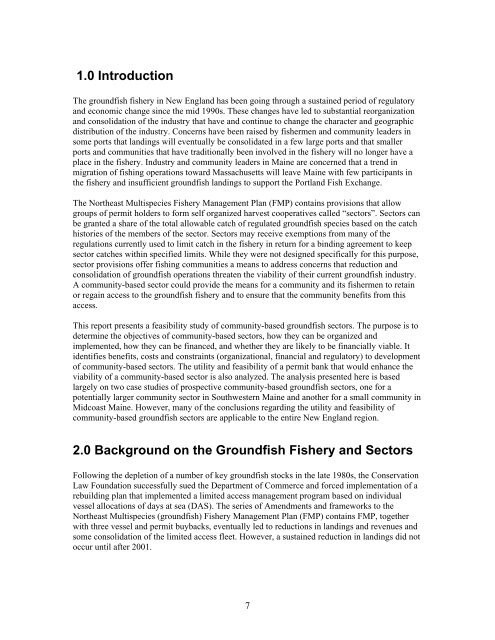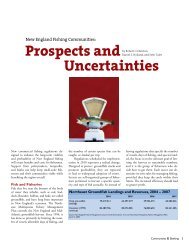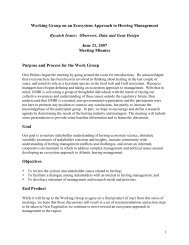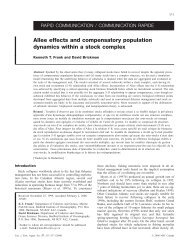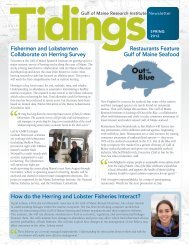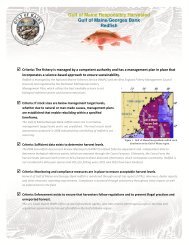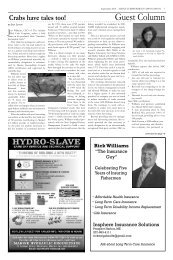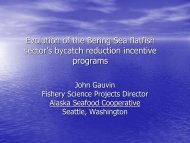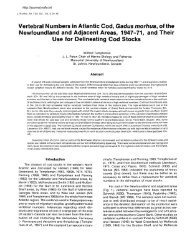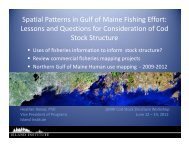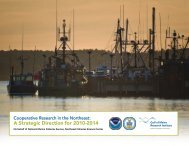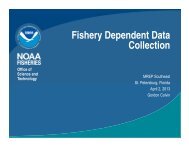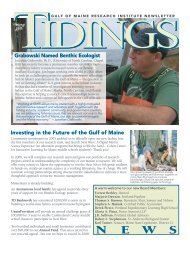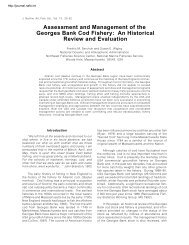Community-based Sectors for the New England Groundfish Fishery
Community-based Sectors for the New England Groundfish Fishery
Community-based Sectors for the New England Groundfish Fishery
You also want an ePaper? Increase the reach of your titles
YUMPU automatically turns print PDFs into web optimized ePapers that Google loves.
1.0 Introduction<br />
The groundfish fishery in <strong>New</strong> <strong>England</strong> has been going through a sustained period of regulatory<br />
and economic change since <strong>the</strong> mid 1990s. These changes have led to substantial reorganization<br />
and consolidation of <strong>the</strong> industry that have and continue to change <strong>the</strong> character and geographic<br />
distribution of <strong>the</strong> industry. Concerns have been raised by fishermen and community leaders in<br />
some ports that landings will eventually be consolidated in a few large ports and that smaller<br />
ports and communities that have traditionally been involved in <strong>the</strong> fishery will no longer have a<br />
place in <strong>the</strong> fishery. Industry and community leaders in Maine are concerned that a trend in<br />
migration of fishing operations toward Massachusetts will leave Maine with few participants in<br />
<strong>the</strong> fishery and insufficient groundfish landings to support <strong>the</strong> Portland Fish Exchange.<br />
The Nor<strong>the</strong>ast Multispecies <strong>Fishery</strong> Management Plan (FMP) contains provisions that allow<br />
groups of permit holders to <strong>for</strong>m self organized harvest cooperatives called “sectors”. <strong>Sectors</strong> can<br />
be granted a share of <strong>the</strong> total allowable catch of regulated groundfish species <strong>based</strong> on <strong>the</strong> catch<br />
histories of <strong>the</strong> members of <strong>the</strong> sector. <strong>Sectors</strong> may receive exemptions from many of <strong>the</strong><br />
regulations currently used to limit catch in <strong>the</strong> fishery in return <strong>for</strong> a binding agreement to keep<br />
sector catches within specified limits. While <strong>the</strong>y were not designed specifically <strong>for</strong> this purpose,<br />
sector provisions offer fishing communities a means to address concerns that reduction and<br />
consolidation of groundfish operations threaten <strong>the</strong> viability of <strong>the</strong>ir current groundfish industry.<br />
A community-<strong>based</strong> sector could provide <strong>the</strong> means <strong>for</strong> a community and its fishermen to retain<br />
or regain access to <strong>the</strong> groundfish fishery and to ensure that <strong>the</strong> community benefits from this<br />
access.<br />
This report presents a feasibility study of community-<strong>based</strong> groundfish sectors. The purpose is to<br />
determine <strong>the</strong> objectives of community-<strong>based</strong> sectors, how <strong>the</strong>y can be organized and<br />
implemented, how <strong>the</strong>y can be financed, and whe<strong>the</strong>r <strong>the</strong>y are likely to be financially viable. It<br />
identifies benefits, costs and constraints (organizational, financial and regulatory) to development<br />
of community-<strong>based</strong> sectors. The utility and feasibility of a permit bank that would enhance <strong>the</strong><br />
viability of a community-<strong>based</strong> sector is also analyzed. The analysis presented here is <strong>based</strong><br />
largely on two case studies of prospective community-<strong>based</strong> groundfish sectors, one <strong>for</strong> a<br />
potentially larger community sector in Southwestern Maine and ano<strong>the</strong>r <strong>for</strong> a small community in<br />
Midcoast Maine. However, many of <strong>the</strong> conclusions regarding <strong>the</strong> utility and feasibility of<br />
community-<strong>based</strong> groundfish sectors are applicable to <strong>the</strong> entire <strong>New</strong> <strong>England</strong> region.<br />
2.0 Background on <strong>the</strong> <strong>Groundfish</strong> <strong>Fishery</strong> and <strong>Sectors</strong><br />
Following <strong>the</strong> depletion of a number of key groundfish stocks in <strong>the</strong> late 1980s, <strong>the</strong> Conservation<br />
Law Foundation successfully sued <strong>the</strong> Department of Commerce and <strong>for</strong>ced implementation of a<br />
rebuilding plan that implemented a limited access management program <strong>based</strong> on individual<br />
vessel allocations of days at sea (DAS). The series of Amendments and frameworks to <strong>the</strong><br />
Nor<strong>the</strong>ast Multispecies (groundfish) <strong>Fishery</strong> Management Plan (FMP) contains FMP, toge<strong>the</strong>r<br />
with three vessel and permit buybacks, eventually led to reductions in landings and revenues and<br />
some consolidation of <strong>the</strong> limited access fleet. However, a sustained reduction in landings did not<br />
occur until after 2001.<br />
7


